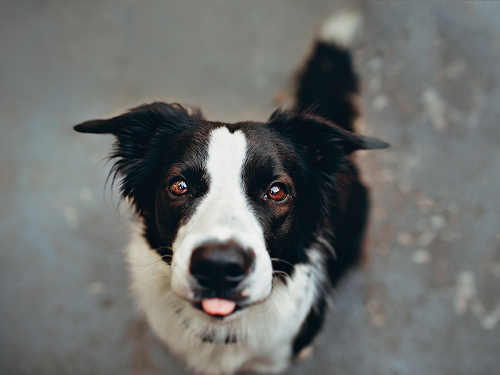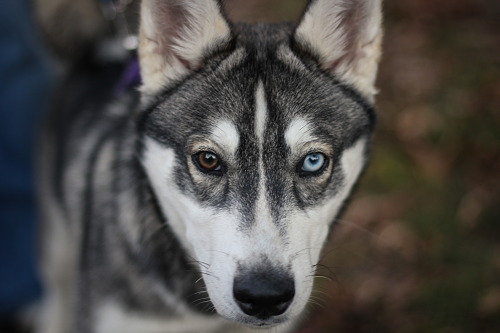Have you ever wondered, “Are dogs colorblind?” You hope he sees your smiling face and can read just how much you love him, but you don’t really know. For years, the myth that all dogs are colorblind has been widely accepted. After early research suggested dogs were colorblind, owners and scientists alike were happy to assume their dogs saw in shades of grey. Recently, those myths have been debunked and it is now known that dogs can see much more than people ever thought before. Just like their owners, dogs can also see the world in color. If you were one of those individuals who always asked, “Are dogs actually colorblind?”, this article is for you.
This blog is going to discuss what it actually means to be colorblind and cover different components of a dog’s sight.
What Does it Mean to Be Colorblind?
The main symptom of being colorblind is that you cannot see colors in the normal way other people do. Typically, it means you cannot distinguish certain colors from others or see one color when others see another. Color blindness occurs when one or multiple color cone cells are absent from the retina. The retina has two kinds of cells called rods and cones that detect light and the cones specifically detect color. You and your dog both have light-sensing cells in your retina that are:
- Cones – their purpose is to work mostly in bright light and manage the perception of color based on what light your eyes absorb
- Rods – these work in low light and capture fast movement and other small changes in your surroundings
Color blindness can range from mild to severe depending on how many cones are absent from the retina. While generally a condition that affects people and animals from birth, it can also come on later in life, which may be a symptom of a much more serious condition.
While humans have three separate cones in their retinas, dogs only have two. Dog’s cones are color sensitive to yellow and blue while the cones in people’s eyes are more sensitive to red, green and blue light. Dogs can distinguish objects of different colors they cannot see but cannot see the colors as people see them. A dog’s vision is like a person’s vision that is suffering from deuteranopia color blindness.
Types of color blindness include:
- Protanopia – a serious type of red-green color blindness which affects long wavelength lights and makes reds look grey and greens look beige
- Deuteranopia – this type affects your greens and medium wavelength lights and still makes it so you cannot see reds and greens, but you will still be able to distinguish them from grey and beige unlike people with protanopia
- Tritanopia – a very rare type of colorblindness that affects short wavelengths and the colors yellow and blue but can make it hard to distinguish any and all colors from one another
Your Dog’s Eyes
Your dog has the same basic make up in his eyes as people do. His eyes are made up of a cornea, pupil, lens, retina and cones and rods inside the retina. While human retinae are composed of almost 100 percent cones in the central area, your dog’s are made of  only around 20 percent. These cones are what capture and translate light and color in the eye and brain and without them, your dog loses some colors on the spectrum. Professionals call this condition being spectrum challenged.
only around 20 percent. These cones are what capture and translate light and color in the eye and brain and without them, your dog loses some colors on the spectrum. Professionals call this condition being spectrum challenged.
Your dog has something called dichromacy. Dichromats, animals with two functioning cones in their retinas, only have two color spectrums they see. While in people, this is a type of colorblindness most prominent in males. This red-green colorblindness is just a deficit for your dog, he can still see much more than black and white.
Your dog’s eyes are built for hunting. Since your dog evolved from a seasoned hunter, he still retains the heightened eye functions. Due to his lack of color and lack of the same close vision quality as people, he also has other heightened senses such as sound and smell, which also help to make him a better hunter.
Does My Dog Have Night Vision?
Since your canine has a different retinal make-up than you, he is more adapted to see in the dark. This is not night vision, per say, but an evolutionary trait which allows him to hunt better in low light. While his eyes only have two cones to receive color, the retinas are well adapted to tracking and hunting at night. Your dog has a bigger lens, corneal surface and a reflective tapetum which allows him to catch minimal movements in the dark. His eye’s cones are more sensitive to picking up distant movements and will always be able to see more than you in the dark. These retinas are also trained for picking up quick movements in daylight.
Your Dog’s Other Senses
Since your dog is missing his red and green light cone in his retina, his visual senses are slightly diminished. Although he has other visual adaptations that help him, your dog needs heightened senses in other places to ensure his ancestors could hunt and survive in the wild. Because of this vision deficit, he has evolved to have keen senses of smell and hearing which alleviate some potential issues.
Your dog’s incredible sense of smell is his most valuable predatory asset. Your dog has over 300 million olfactory receptors in his nose which allow him to track prey morning, noon or night, regardless of visibility. In comparison, human’s only have about six million. Olfactory receptors are tiny, hair-like smell receptors inside of the nasal passage that transport information to the brain about what exactly it is you’re smelling. In addition to this, your dog also has a larger portion of his brain dedicated to analyzing smells.  So, while your dog may only see shades of certain colors, he can smell things from a mile away.
So, while your dog may only see shades of certain colors, he can smell things from a mile away.
Your dog has also developed an acute sense of sound. Have you ever seen your dog perk up or have an ear twitch when you swear there isn’t anything going on around you? Well, your dog is probably hearing something you could never dream of hearing. Your dog’s hearing is wired for trapping prey that give off high-pitched sounds and very soft sounds. His highly sensitive ears can pick up the sound of a mouse scurrying through the brush or your neighbor coming over to ask for some sugar long before you even knew they were at your door.
These senses paired with your dog’s superior night vision make him a fierce predator and guard dog for you.
How Does Your Dog Distinguish Objects?
Since your dog does not see color on the same spectrum as you do, he must have other ways to determine where and what an object is. While humans can see a wider spectrum of color and use this to differentiate items and organisms, dogs must rely more on movement. When a small rodent darts from tree to tree or through the grass, your dog’s sharp eyes will pick up the movement in a heartbeat. This ability to pick up movement makes him an elite predator and makes up for his inability to see all colors. The inability of a dog’s retinas to see objects sharply and tell the difference between color makes him rely on contrast of color as well. A dark brown couch cushion on a light brown couch will not necessarily look incredibly different in color but your dog will be able to tell it’s not the same on the spectrum.
What Colors Can My Dog See?
Dogs process and see color on a yellow to blue spectrum with some gaps. Your dog has a much easier time seeing colors like blue and purple. This is because of the two cones dog’s possess. In turn, dogs cannot see red, green or shades of orange. Dogs see a different spectrum than humans all together and will never be able to see all the colors in the rainbow.
Knowing that your dog is spectrum-challenged can help you to realize why certain toys may be more exciting for him or why he cannot see the green tennis ball when it’s in the grass. Next time you go to buy a new toy, you’ll know shades of red might not be the most appealing for your dog.
Ultimately, your dog may see things a little differently than you, but he is getting a full perception of the world around him and the lack of certain colors does not affect his day-to-day experience.
Sources
Akc. “Are Dogs Color Blind?” American Kennel Club, 12 Nov. 2015, www.akc.org/expert-advice/lifestyle/are-dogs-color-blind/.
“Dichromacy.” Wikipedia, Wikimedia Foundation, 16 Mar. 2019, en.wikipedia.org/wiki/Dichromacy.
Osmanski, Stephanie. “Are Dogs Colorblind? A Guide to What Your Pup Can (and Can’t!) See.” Dogster, 1 June 2018, www.dogster.com/dog-health-care/are-dogs-colorblind-a-guide-to-what-your-dog-sees.
petMD. “PetMD.” PetMD, 2 Oct. 2017, www.petmd.com/dog/general-health/what-colors-do-dogs-see.




